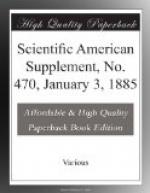C. (-153 deg. Fahr.). M. Wroblewski, of
Cracow, who had witnessed some of M. Cailletet’s
experiments, and obtained his apparatus, and M. Olzewski,
in association with him, also experimented with ethylene,
and had the pleasure of recording their first complete
success early in April, 1883. Causing liquid ethylene
to boil in an air-pump vacuum at -103 deg. C.,
they were able to produce a temperature of -150 deg.
C. (-238 deg. Fahr.), the lowest that had ever
been observed. Oxygen, having been previously
compressed in a glass tube, became a permanent liquid,
with a clearly defined meniscus. It presented
itself, like the other liquefied gases, under the
form of a transparent and colorless substance, resembling
water, but a little less dense. Its critical point
was marked at -113 deg. C. (-171 deg. Fahr.),
below which the liquid could be formed, but never
above it; while it boiled rapidly at -186 deg.
C. (-303 deg. Fahr.). A few days afterward,
the Polish professors obtained the liquefaction of
nitrogen, a more refractory gas, under a pressure of
thirty-six atmospheres, at -146 deg. C. (-231
deg. Fahr.). Long, difficult, and expensive
operations were required to produce this result, for
the extreme degree of cold it demanded had to be produced
by boiling large quantities of ethylene in a vacuum.
M. Cailletet devised a cheaper process, by employing
another hydrocarbon that rises from the mud of marshes,
and is called
formene. It is less easily
liquefied than ethylene, but for that very reason
can be boiled in the air at a lower temperature, or
at -160 deg.C. (-256 deg. Fahr.); and at this
temperature nitrogen and oxygen can be liquefied in
a bath of formene as readily as sulphurous acid in
the common freezing mixture.
MM. Cailletet, Wroblewski, and Olzewski have
continued their experiments in liquefaction, and acquired
increased facility in the handling of liquid ethylene,
formene, atmospheric air, oxygen, and nitrogen.
M. Olzewski was able to report to the French Academy
of Sciences, on the 21st of July, 1884, that by placing
liquefied nitrogen in a vacuum he had succeeded in
producing a temperature of -213 deg.C. (-351 deg.
Fahr.), under which hydrogen was liquefied. Contrary
to the suppositions founded on the metallic behavior
of this element, that it would present the appearance
of a molten metal, like mercury, the liquid had the
mobile behavior and the transparency of the hydrocarbons.
* * * *
*
EXAMINATION OF FATS.
The methods employed up to the present in examination
of fats, animal and vegetable, are mere reactions
lacking general application; scattered throughout
the literature, and doubtful with regard to reliability,
they are of little or no value to the experimenter—an
approximate quantitative examination even of a simple
mixture being exceedingly difficult if not impossible,
since the qualitative composition of fatty substances




